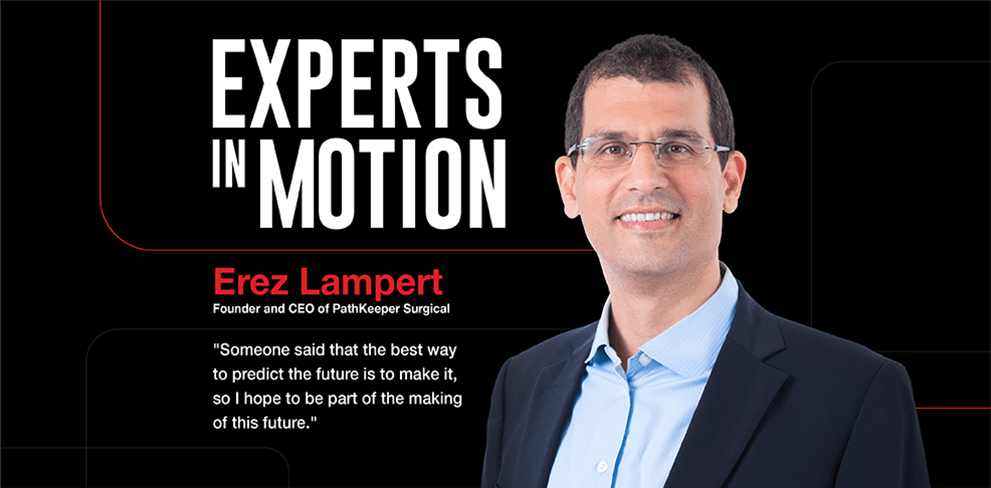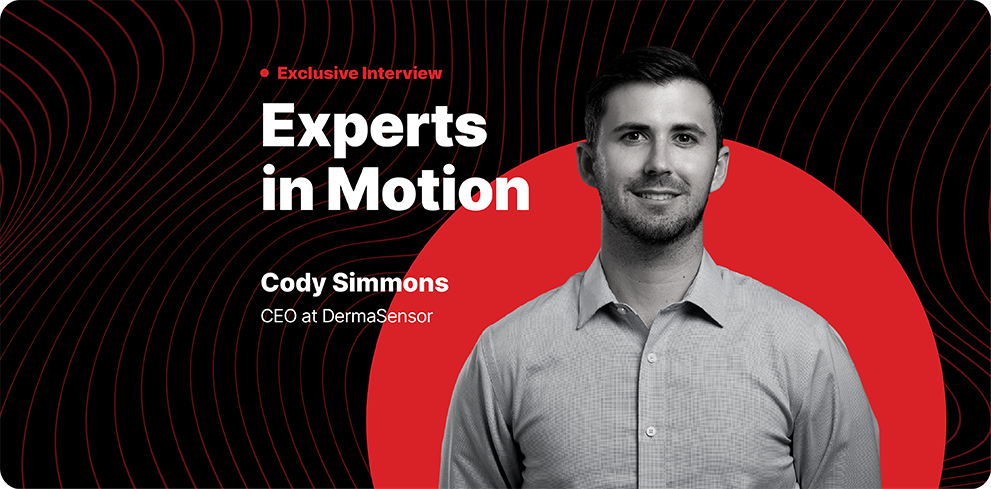Erez Lampert, PathKeeper Surgical, CEO, on the AI-Driven 3D Imaging Revolution

Erez Lampert, PathKeeper Surgical, Founder and CEO
Guillaume: Erez, it’s a pleasure to have you with us. With all that’s happening in Israel, how are you holding up, especially at the helm of a MedTech company?
Erez: These are indeed challenging times, but as you know, Israel has been struggling for its existence literally since our Declaration of Independence, so we are a resilient bunch. That being said, being a company founder with a developed sense of responsibility towards my partners, employees, customers, and all other stakeholders, in addition to being a father, is certainly new to me. In some unexpected way, I feel it is strengthening me and motivating me to perform better than ever; not only keeping things together but outperforming, in these challenging times.
Guillaume: In these challenging times, how do you ensure your team’s mental well-being and safety?
Erez: Everyone is going through a different experience, although the objective situation is the same. Everyone is affected differently; some have friends and relatives involved in the atrocities of 10/7, and others have relatives or acquaintances recruited to the reserve, worrying about them. I see my role as holding all this together, with a lot of sensitivity towards an individual’s situation. We are making extra efforts to encourage teamwork these days because this is not a good time for people to work independently.
Guillaume: Have the ongoing geopolitical factors in Israel shaped your leadership style or influenced any major business decisions?
Erez: Yes, I believe so. I am being much more sensitive to what is going on around me. I fully understand that some customers, partners, suppliers, or others, may have issues with what is happening now. Politics is not a good small-talk segue into a business discussion, on the other hand, completely ignoring what is going on is also not a good idea. I start my video conference with meetings with people abroad by apologizing that if there is a missile barrage, I will have to run to my bomb room for 10 minutes, since we are experiencing 2-3 of these daily, we can’t just ignore this. At the business decision level, we have decided to continue as usual. The only issue we have decided to keep on hold is the current expansion of installations in Israel; it’s not a good time to engage new customers, but we continue at full speed in the US.
Guillaume: Let’s rewind a bit. Can you walk us through your beginnings in 3D Imaging for Medical Devices and what led to the birth of PathKeeper Surgical in 2018?
Erez: I have been developing 3D imaging medical devices, since 2012, when I joined Align Technology as an R&D manager. Align technology 3D cameras enable dentists to measure accurately, plan, and perform more accurate orthodontist and restorative dentistry. The iTero Element we developed was an overnight success, selling over 2000 systems in the first conference it was presented. The next step in my journey came in early 2018. I started talking to orthopedic surgeons about their clinical needs, looking for a pain I could resolve. I met a spine surgeon who shared with me his frustrations with current “state-of-the-art” technology. We felt that optical scanning could replace CT scanning as a baseline for spinal surgery navigation and robotics.
Guillaume: For those of us less versed in the technicalities, could you break down the essence of the 3D optical spine navigation system and its edge over other technologies?
Erez: In essence, let’s demonstrate this by inserting a pedicle screw into a pedicle in the lumbar spine. Insert it too close to the middle, and you may hurt the spinal cord; insert it too close to the external perimeter, and the integrity of the structure may be jeopardized. It’s quite similar to driving a screw into a wall: Is there a waterpipe where I insert the screw? Electricity? But the spinal case is much more complex, because, as opposed to the wall, the patient could move during the procedure, and someone could have touched the patient or the bed, so the imaging needs to be continuous.
Today, the surgeon will insert a tracker and then perform a CT scan, where the tracker can be seen. If the surgeon feels the patient has moved, they will redo the CT scan. That can accumulate a lot of radiation for the patient and the OR staff and a lot of extra time in the surgery room. We are eliminating all of this, including the OR CT machine. We installed a small 3D camera, and now the surgeon can take another optical scan anytime they want. The AI will update the anatomical map, like a Waze system updating traffic situations, and ensure the surgeon gets accurate data to perform precise operations.
Guillaume: Every journey has its hurdles. What were some standout technological or scientific challenges for PathKeeper, and how did you overcome them?
Erez: PathKeeper technology has two pillars: 3D imaging and Artificial Intelligence. Neither was straightforward to solve. PathKeeper CTO, Dr. Opher Kinrot has scientific and technical expertise in optics. I led the team that created the ITero 3D intra-oral camera. We both went into developing a 3D camera for spinal surgery with confidence, but our first iteration was a complete bust.
The quality of the 3D was great on a saw-bone model, so we got the spine of a pig, went into a veterinarian’s surgery room, and tried to scan a spine, and the results were poor. We had to go back and rethink everything we thought we knew and spend 6 more months improving the camera till it reached the quality we believed was needed for our vision. There is no magic in technology or science, just hard work, openness to new ideas and external experts, and keeping at it till you make it work. As time passes, we do our best to bring smart people together and combine forces to solve the next big challenge.
Guillaume: I’ve heard you’ve collaborated closely with spine surgeons and industry experts. How did their feedback shape the system? And is it true you’ve built a global network of advisors?
Erez: PathKeeper started with a discussion with a spine surgeon who wasn’t happy with the current state-of-the-art technology. His vision for a high-quality navigation solution that is low-cost and mobile enough to be used everywhere started the company. I contacted more spine surgeons for their feedback and guidance as time passed. Some become investors, mentors, and friends; their guidance leads us through the process.
For example, as we talked about our capabilities, we realized that we are uniquely placed to measure changes in the surgery room and that there is value in anatomical tracking and giving specific data in real-time to the surgery, and that led us to measure the alignment of the spine during the surgery. I could say that today, we have surgeons’ feedback and guidance from the US, Israel, Europe, and APAC. It’s truly a global team.
Guillaume: Given your deep roots in 3D imaging, where do you think the future lies for this technology in MedTech?
Erez: Align technology is still my inspiration. Align led a digital transformation in dentistry, and I am proud to be part of it. More and more, dentists can measure, analyze, and predict outcomes in orthodontic care. I feel patients requiring orthopedic intervention are entitled to the same level of treatment. I would like to see a future where back pain, leg pain, and similar patients receive accurate analysis and prediction on what needs to be done and the potential outcomes. Surgeons can plan the surgery and perform it with the same accuracy; they plan it, and the outcomes are analyzed and used to improve future treatment. Someone said that the best way to predict the future is to make it, so I hope to be part of the making of this future.
Guillaume: How do you envision the future of PathKeeper Surgical and its innovations in the next ten years?
Erez: 2024 is going to be a critical year for us. PathKeeper optical navigation system with deformity tracking and MIS support will be in the market and face scrutiny of the surgical community. However, that is just the beginning of our vision for digital surgery. We would like to support the surgeon throughout the surgical process to navigate interbody implants to support Osteotomies and tumor resections.
We want to be there before surgery, supporting the clinical analysis of the patient and the decision-making of the best intervention for the patient, and we want to be there after surgery to support the learning of the retrospective process. We will expand beyond the spine to anything with a bone: Joints, cranial, and extremities. Now, all of that must make surgeons’ lives easier. Surgeons are one of the hardest-working professionals. As engineers and innovators, we should make their lives easier. We use AI and a lot of hard work to simplify processes for surgeons. Yes, we need better outcomes, but it must be with the same or less work for the surgeon.
Guillaume: In your opinion, considering the world we live in, how can MedTech companies best pivot and adapt in rapidly shifting landscapes, be it political or technological?
Erez: I believe in a “philosophical” state of mind, which means I know my ignorance and keep questioning my assumptions. However, there is a balance between flying in the wind, pivoting from every little comment or feedback you get, and being stuck in your ways and not listening to anyone. So, I keep asking for advice and feedback, keep my eyes and ears open, and learn from everyone: surgeons, distributors, and businessperson. At the end of the day, there is a “leap of faith” in who to trust. Who are your trusted advisors? What level of evidence does one need to pivot?
The last step is jumping. After collecting evidence, learning from everyone, and consulting with your trusted advisors, you need to jump and do what’s necessary, pivot, or stay the course. You can’t do both. So, Jump. Be all in on your decision.
Guillaume: To wrap up, any words of wisdom you’d like to offer entrepreneurs and professionals launching MedTech ventures?
Erez: The road is going to be hard so make sure you do something that is worth doing. Make sure you are doing it for the right reasons, because if you do, you will be able to keep your spirit and your energy.
Interested in hearing from more “Experts in Motion”? Take a look at more interviews in our Experts in Motion series.













